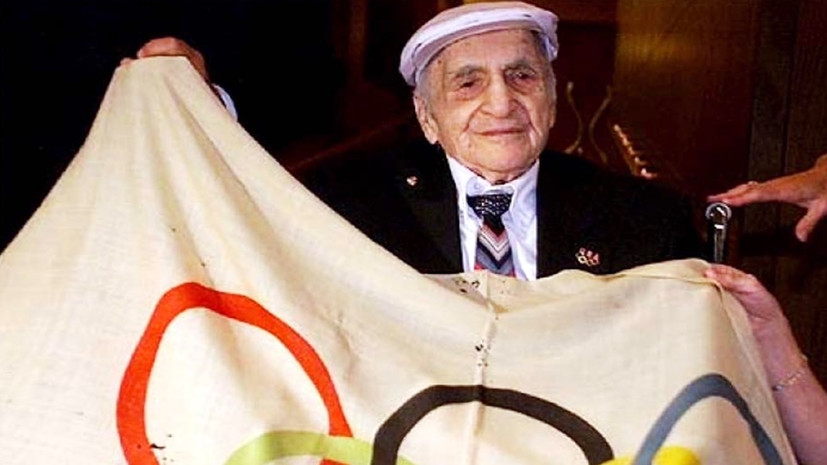The VII Summer Olympic Games of 1920, held from 14 to 29 August in Antwerp, Belgium, were marked by a significant event. The most important symbol, the Olympic flag, was presented there for the first time. However, just before the closing ceremony, one of the panels disappeared. Nothing was known about his fate for 77 years.
The presentation of the most recognizable sports logo took place back in 1914 at the first congress of the International Olympic Committee (IOC) in Paris. It was personally developed by the initiator of the resumption of the Games, Baron Pierre de Coubertin. According to his idea, the flag was supposed to convey the universality of the Olympic movement, which unites the entire planet. That is why the intertwined rings symbolized the five cardinal points - Europe, Asia, Africa, North and South America and Oceania, and six colors, including a white background, - the coloring of the flags of the states of the world.
“Are these rings tightly chained together? Will not one day undermine the Olympic principles? " Coubertin wondered.
But precisely because of the First World War, the flag had to wait for its finest hour for six years. The expectation paid off: the participants of the 1920 Olympics liked the new symbol. So much so that some athletes decided, under cover of night, to remove the banners hung all over Antwerp and take them home as souvenirs. But the Belgian police were on the alert, and the unfortunate thieves had to be punished.
Nevertheless, it was not possible to see behind one flag. Historian Miles Garcia argued that it was he who should have been used during the so-called Antwerp ceremony, well known to connoisseurs of sports. Its essence lies in the fact that the head of the city - the host of the competition, transfers the banner to his colleague from the venue of the next Games. Due to the loss, this ritual was first performed only in 1924 in Paris, although it was mistakenly named after the Belgian Olympics.
Law enforcement agencies failed to find either the robber or the missing person. However, the secret always becomes apparent and sometimes completely by accident.
Armenian American Haig Priest was born in 1896, the year the Games were revived. He worked as an actor and stuntman, starred in the first silent films, and then decided to try his hand at sports and got into the Olympic team at the competition in Antwerp. There he won bronze in jumping from a 10-meter platform. However, he managed to take away not only a medal from Belgium.
A story worthy of a detective story might not have happened if not for Priest's national teammate, the famous swimmer Duke Kahanamoku. It was he who took the athlete "weakly" and encouraged him to climb a 4-meter flagpole in order to remove the Olympic flag.
“We were together all the time, constantly making some kind of jokes, like Stan Laurel and Oliver Hardy (popular comedy duo. - RT ). He was a great guy with a great sense of humor, ”recalled Priest Kahanamoku.
But the main difficulty was to take the "trophy" home. But here, too, the athlete was lucky and the symbol of the Olympics packed in a simple suitcase was not found at the border.
One would expect Priest to hang a memento at his California home, but this is not the case. For many decades, he lay folded, hidden from prying eyes. There were several explanations for this. Firstly, the diver in the water did not think that the banner was of any value, and, accordingly, a reason for pride. Secondly, he was uncomfortable for his daring act.
The fact that one of the main relics of sports history is in Priest's possession was revealed at a reception organized by the US Olympic Committee in 1997. The journalist interviewed the oldest medalist of the Games at that time and asked if he knew the fate of the flag, hardly hoping to get a solution to the long-standing mystery. However, an unexpected response followed.
“I can help you with this. It's in my suitcase, ”Priest said.
Three years later, the flag returned to its rightful owners. The former diver handed it personally to IOC head Juan Antonio Samaranch at the organization's congress in Sydney ahead of the 17th Summer Olympic Games. Many were afraid that the 103-year-old American would not be able to travel to another continent due to health conditions, but the fears were in vain: a big sports fan, Priest kept himself in shape until the last years of his life, regularly did exercises and even skated. He had to start using the wheelchair only shortly before his trip to Australia.
“I give the flag to them. Soon I will be gone. The flag was with me for a long time. Many of my friends have seen him. But in such situations, you should not be selfish. This is not good of me. Can't hang it on my wall. People will have a better impression of me if I give it away, and not leave it with me, ”Priest explained his act.
The flag, in almost perfect condition - with the exception of a slightly faded paint and frayed edges - was transferred to the Olympic Museum in Lausanne. At the same time, the President of the US Olympic Committee, William Heble, jokingly or seriously said that he had contacted Belgian law enforcement agencies. They assured that Priest need not fear punishment for his crime, since the case was closed due to the statute of limitations.

